
The 30 Most Amazing Ancient Artifacts in Human History
- Definition of Ancient Artifacts:
- An object is classified as “ancient” if it originates from the ancient period (3000 BCE to 400 CE).
- Marks the emergence of permanent civilizations with systems like writing and record-keeping.
- Entities/Attributes: Ancient period, artifacts, civilizations, writing systems.
- The Rosetta Stone (196 BCE):
- Found in Egypt, it enabled the translation of Egyptian hieroglyphs through its trilingual inscription.
- A cornerstone discovery for understanding Ancient Egyptian history.
- Entities/Attributes: Egyptian hieroglyphs, translation, British Museum.
- Dead Sea Scrolls (3rd Century BCE-1st Century CE):
- A collection of 900 texts discovered in the West Bank, containing Hebrew Bible manuscripts and insights into Jewish discourse.
- Written in Hebrew, Aramaic, and Greek.
- Entities/Attributes: Hebrew Bible, ancient Judaism, Israel Museum.
- Terracotta Army (210 BCE):
- 6000 unique warrior statues from Emperor Qin Shi Huang’s tomb in Xian, China.
- Demonstrates ancient Chinese craftsmanship and funerary practices.
- Entities/Attributes: Qin Shi Huang, funerary art, Xian.
- Tutankhamun’s Funerary Mask (1323 BCE):
- Crafted from gold and gemstones, symbolizing Ancient Egyptian funerary rituals.
- Discovered in the 1920s by Howard Carter.
- Entities/Attributes: Ancient Egypt, gold funerary art, Egyptian Museum.
- Nebra Sky Disk (1600 BCE):
- The first known depiction of the night sky, made of bronze with gold inlays.
- Likely used for religious or scientific purposes by the Unetice culture in Europe.
- Entities/Attributes: Bronze Age, astronomy, Germany.
- Olmec Colossal Heads (900 BCE):
- Massive basalt sculptures, representing Olmec rulers, found in Mexico.
- Highlight the advanced artistry of the ancient Mesoamerican Olmec civilization.
- Entities/Attributes: Olmec civilization, Mesoamerica, Veracruz.
- Parthenon Sculptures (447-432 BCE):
- Marble statues from the Parthenon in Athens, representing the goddess Athena.
- Controversially housed in the British Museum, with fragments in Greece.
- Entities/Attributes: Parthenon, Athena, Ancient Greece.
- Quipu of Caral (3000 BCE):
- A record-keeping system using knots and cords, found in one of the oldest American civilizations.
- Shows early systems of data recording in Peru.
- Entities/Attributes: Caral civilization, record-keeping, Peru.
- Code of Hammurabi (1750 BCE):
- A Babylonian stele containing 282 codified laws inscribed in cuneiform.
- Reflects early legal systems in Ancient Mesopotamia.
- Entities/Attributes: Hammurabi, cuneiform, Babylon.
- Bust of Nefertiti (1345 BCE):
- A strikingly realistic bust of the Egyptian queen, crafted with intricate detail.
- Housed in Berlin, despite Egyptian efforts to repatriate it.
- Entities/Attributes: Nefertiti, Ancient Egypt, Neues Museum.
- Ishtar Gate (6th Century BCE):
- A monumental blue-glazed gate adorned with images of deities, marking Babylon’s entrance.
- A prime example of Mesopotamian art and architecture.
- Entities/Attributes: Babylon, Nebuchadnezzar, Pergamon Museum.
- Dancing Girl of Mohenjo-Daro (2500 BCE):
- A bronze statue showing advanced metalworking by the Indus Valley Civilization.
- Indicates cultural appreciation for dance and performance.
- Entities/Attributes: Indus Valley, bronze sculpture, Mohenjo-Daro.
- Tollund Man (400 BCE):
- A naturally mummified body from Denmark, showing evidence of ritualistic practices.
- Offers insights into Iron Age life and beliefs in Northern Europe.
- Entities/Attributes: Natural mummification, Iron Age, Denmark.
- Flood Tablet (7th Century BCE):
- Part of the Epic of Gilgamesh, recounting a flood narrative resembling the biblical story of Noah.
- Demonstrates cross-cultural storytelling and shared myths.
- Entities/Attributes: Epic of Gilgamesh, Mesopotamia, British Museum.
Conclusion:
Ancient artifacts provide invaluable insights into the civilizations of the past, their cultures, technologies, and beliefs. These artifacts, such as the Rosetta Stone, Dead Sea Scrolls, and Terracotta Army, not only amaze us with their craftsmanship but also connect us to humanity’s shared history. Each relic is a testament to the ingenuity and creativity of our ancestors, preserving their legacies for generations.
Over the last several hundred years, humans have begun diligently collecting, documenting, and studying objects made or altered by humans from long ago. The field of archaeology has given us some incredible artifacts from far-flung excavations globally.
These items aren’t just amazing to behold; they help us shed light on the people of the past, our ancestors. Below, read about 30 of the most impressive ancient artifacts in human history. Discover the best remnants of the ancient Greek world, Egypt, China, the Americas, and more.
What Makes an Artifact Ancient?
Archaeologists consider an object ancient if it dates to the ancient world. The ancient period is a long age of human history from about 3000 BCE to 400 CE. It follows the prehistoric age and precedes the post-classical era.
The emergence of permanent, stratified civilizations with systems of writing and record-keeping marked the turn from prehistory to ancient. It did not occur uniformly across the globe, leading scholars to dispute the date range.
Still, the objects below all come from the approximate era of about 3000 BCE to the early years of the common era, when the societies that created them entered that phase.
There have been countless ancient artifacts left over from long-gone peoples. These are 30 of the most amazing examples:
1. Rosetta Stone
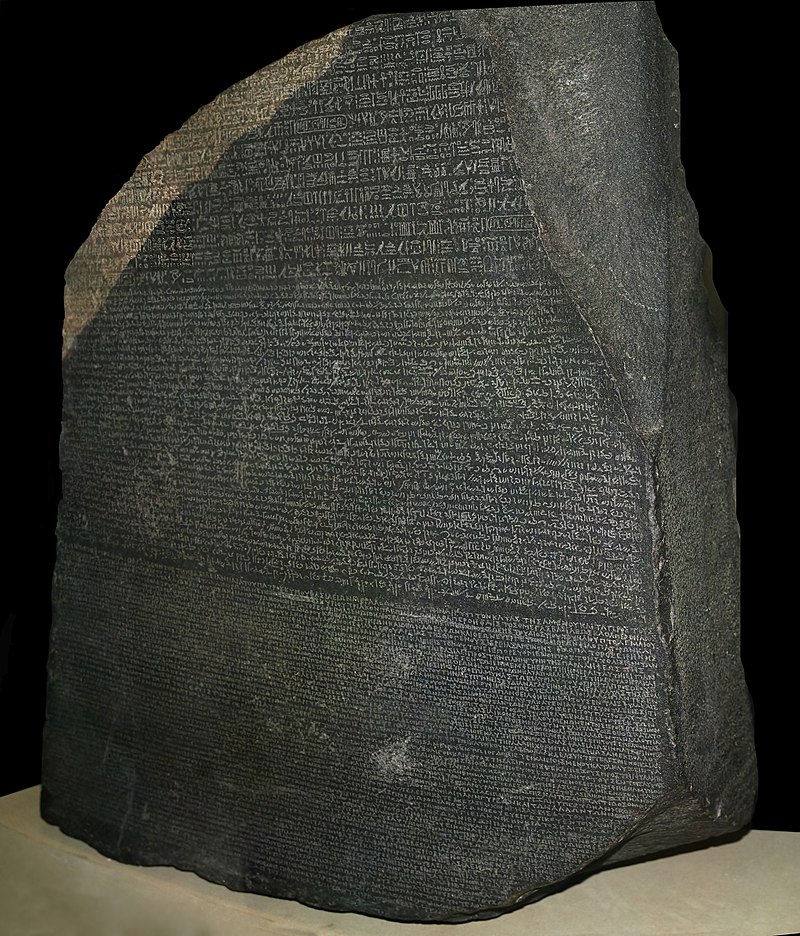
- Date of Creation: 196 BCE
- Origin: Memphis, Egypt
- Date of Discovery: 1799
- Where Displayed: The British Museum, London
The Rosetta Stone is one of the most important discoveries from the ancient world. French soldiers participating in Napoleon’s Egyptian campaign found it in 1799 along the Nile River.
The message on the stone is relatively unremarkable, but it’s written in three languages: two versions of Egyptian hieroglyphs and Ancient Greek. Historians could finally translate hieroglyphics and unlock the secrets of Ancient Egypt.
2. Dead Sea Scrolls

- Date of Creation: 3rd Century BCE to 1st Century CE
- Origin: Qumran
- Date of Discovery: 1947 to 56
- Where Displayed: Most are held in the Israel Museum, Jerusalem
The Dead Sea Scrolls aren’t a single artifact but a series of discoveries made in the West Bank region along the northern coast of the Dead Sea.
Written mainly in Hebrew but also in Aramaic and Greek, the scrolls tell us a great deal about ancient civilizations. There are thousands of fragments composing over 900 texts from a Jewish sect.
They contain some of the earliest versions of books of the Hebrew Bible. The scrolls provide a valuable understanding of ancient Jewish discourse. Other texts have been discovered featuring Arabic and Latin.
Terracotta Army
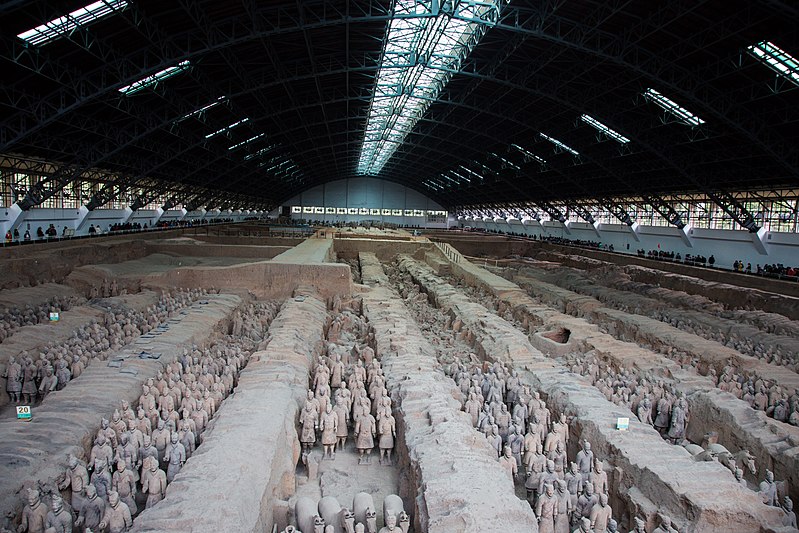
- Date of Creation: Approximately 210 BCE
- Origin: Xian, China
- Date of Discovery: Farmers unearthed them in 1974
- Where Displayed: Xian, China
The Terracotta Army of carved warriors composed a city of their own. There are 6000 statues, all in battle-ready formation. No two are the same; each man has distinctive facial hair, clothing, rank, and more.
Built as funerary art for Emperor Qin Shi Huang, the Terracotta Army reveals incredible insight into life in the 2nd Century BCE in China. These statues stand guard at the tomb of the Emperor to guard him for eternity in the afterlife.
Tutankhamun’s Funerary Mask
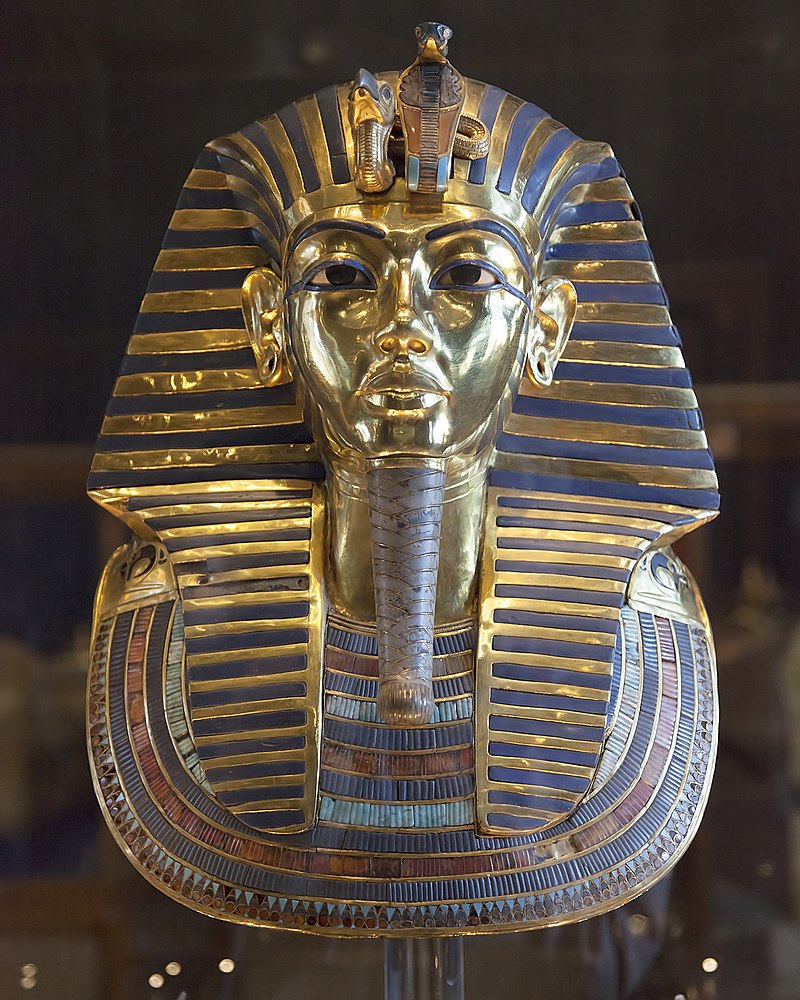
- Date of Creation: 1323 BCE
- Origin: Ancient Egypt
- Date of Discovery: 1925
- Where Displayed: The Egyptian Museum, Cairo
Perhaps one of the best-recognized ancient artifacts, the funerary mask of King Tutankhamun is breathtaking. Ancient Egyptian artisans carved the mask from two layers of inlaid gold, several precious gemstones, and glass.
This Egyptian king was only a child when he ruled, and his boyish features are evident in the mask. It’s one thing that makes it such an enigmatic artifact to behold. British archaeologist Howard Carter discovered the mask after unearthing the king’s tomb in the 1920s.
Ur Ram (Ram in the Thicket)

- Date of Creation: 2600-2400 BCE
- Origin: Ancient Sumerian city of Ur
- Date of Discovery: 1928-9
- Where Displayed: British Museum
The Ur Ram, also called Ram in a Thicket, is a statue of a ram or goat uncovered in the Royal Cemetery at Ur in southern Iraq. There are actually two similar statues that archaeologists found near each other and believe to be a pair.
Artisans crafted it by carving an intricate wooden core and then layering precious metals and other materials on top of it. These included lapis lazuli, gold and gold leaf, copper, and red limestone.
Nebra Sky Disk

- Date of Creation: 1600 BCE
- Origin: Near Nebra, Germany
- Date of Discovery: 1999
- Where Displayed: Halle State Museum of Prehistory, Halle, Germany
This Bronze Age disk gives us the first known depiction of the night sky. It’s made from a bronze base, patina, and gold inlays for the sun, moon, and stars. The artifact measures about 30 centimeters in diameter (just under one foot) and weighs just 2.2 kilograms (4.9 pounds).
We only have clues about the Unetice culture that created the disk, which probably had scientific and religious significance for these ancient people. The only clues about them come from ancient artifacts found throughout Europe.
Olmec Colossal Heads

- Date of Creation: At least 900 BCE
- Origin: Veracruz and Tabasco, Mexico
- Date of Discovery: 1862, although excavations didn’t begin in earnest until the 1930s
- Where Displayed: All of them are in Mexico, including the National Anthropology Museum in Mexico City.
The Olmec Colossal Heads were carved from enormous basalt boulders. They were made by the Olmec people, who have ancient origins in Mesoamerica, primarily in the present-day Mexican states of Veracruz and Tabasco along the coast of the Gulf of Mexico.
Ancient Olmec people carried the stones for more than 150 kilometers. In some cases, the boulders themselves may have been significant, particularly the one from San Lorenzo, Tenochtitlan. Archaeologists and historians believe them to be representations of mighty kings. Each has a unique headdress.
The Parthenon Sculptures (Elgin Marbles)

- Date of Creation: 447-432 BCE
- Origin: Athens, Greece
- Date of Discovery: They never disappeared, but foreign governments began removing them in the early 19th Century.
- Where Displayed: British Museum and Athens
The Parthenon Sculptures, also known as the Elgin Marbles are a collection of marble statues from the Parthenon in Athens, Greece, a temple to the goddess Athena. She ruled over both wisdom and military might.
After the fall of the Ancient Greek world, the Parthenon saw several uses. Indeed, over centuries, wear and tear and sometimes even war destroyed most of the artifacts with ancient origins in the temple. Only about half remain, many in fragments.
Basse Yutz Flagons

- Date of Creation: Approximately 5th Century BCE
- Origin: Eastern France
- Date of Discovery: 1927
- Where Displayed: British Museum
Much about the ancient origins of the Basse Yutz Flagons remains buried in the past. These ceremonial drinking vessels are certainly of Celtic origin, but little is known about where they were found.
Dating from the Iron Age, Celts expertly fashioned them into a single piece from copper alloy.
They have intricate sculptures and semi-precious stones. The flagons are coated with resin to make them watertight, both functional and beautiful.
Trundholm Sun Chariot
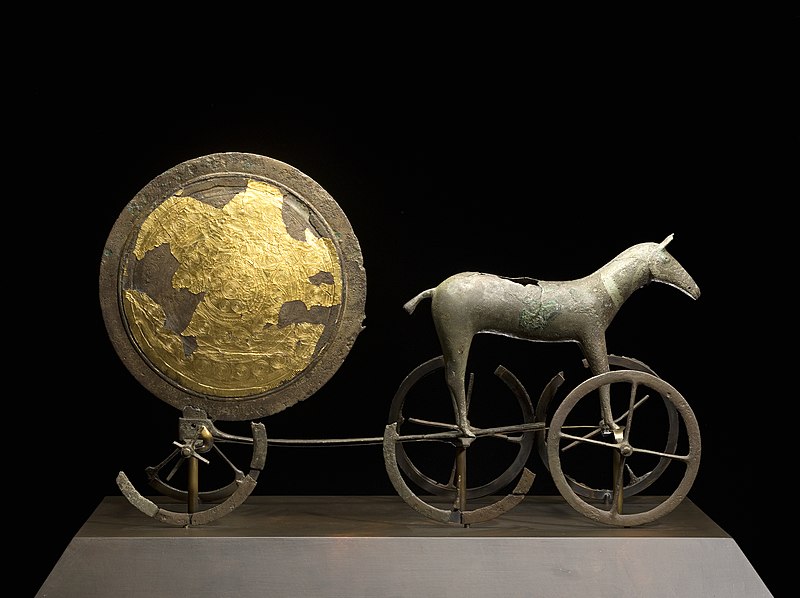
- Date of Creation: Unknown
- Origin: Trundholm, Denmark
- Date of Discovery: 1902
- Where Displayed: National Museum of Denmark, Copenhagen
The Trundholm Sun Chariot is a stunning artifact of the Nordic Bronze Age. It is a bronze statue of a horse and disc (hence the name “Sun Chariot”) on four spoked wheels.
Interestingly, the world of archaeology didn’t uncover this relic of the past. Instead, its discovery happened almost by accident in a peat bog.
Phaistos Disc

- Date of Creation: Bronze Age, probably the second millennium BCE
- Origin: Minoan Palace, Crete
- Date of Discovery: 1908
- Where Displayed: Heraklion Archaeological Museum, Crete
The Phaistos Disc was discovered more than 100 years ago on the Greek island of Crete, but experts have yet to shed light on its meaning.
Consisting of 45 signs or symbols arranged in 241 tokens, no one can discern the artifact’s meaning or how the ancient world would have used it.
Quipu of Caral

- Date of Creation: Around 3,000 BCE
- Origin: Caral, Peru
- Date of Discovery: 1948
- Where Displayed: Caral
Caral is an astounding ancient city in present-day Peru, one of the oldest known civilizations in the Americas. The city is a UNESCO World Heritage Site, and the quipu is one of the most fascinating objects discovered there.
A quipu is a record-keeping system that involves tying knots in ropes and arranging them in particular ways. They were common in the ancient world, but few survived.
Babylonian Map of the World
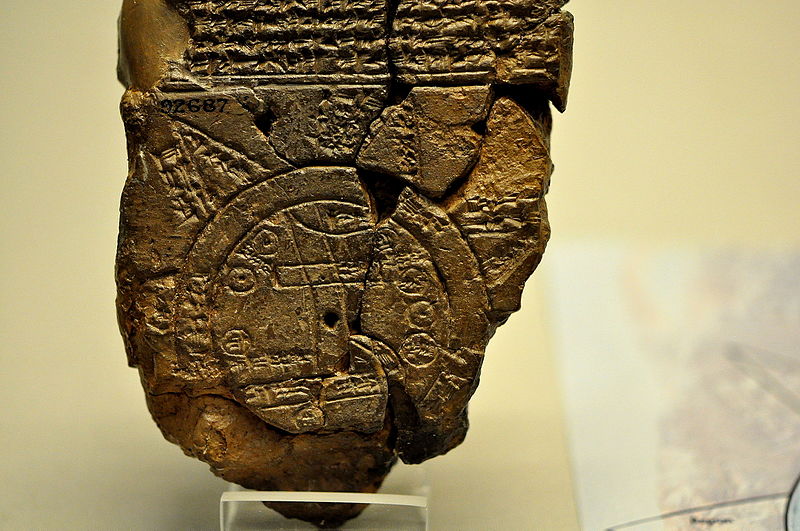
- Date of Creation: Probably 8th or 7th Century BCE
- Origin: Ancient city of Sippar in present-day central Iraq
- Date of Discovery: 1882
- Where Displayed: British Museum
The Imago Mundi, or Babylonian Map of the World, is a clay tablet that displays the world as the ancient Babylonians knew it. It also has a partially-lost description of the map in the written language of the Babylonian people.
In ancient times, travel was limited, but history has shown that our ancestors were more mobile than you might imagine. The Euphrates River, which was central to their lives, is at the center of the map.
Bronze Bells (Bianzhong)
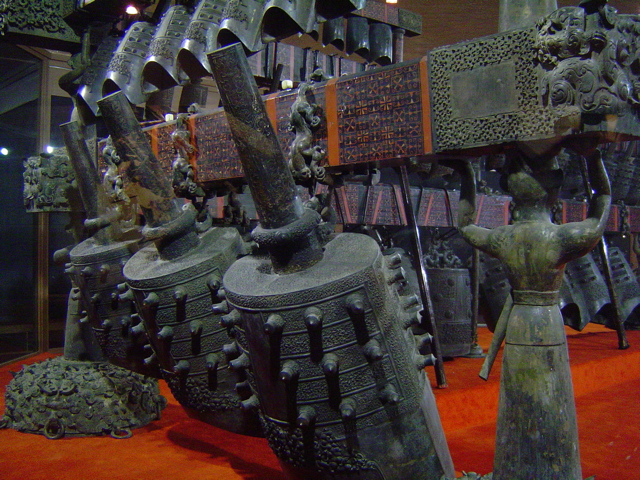
- Date of Creation: 4th Century BCE
- Origin: Wuhan, China
- Date of Discovery: 1978
- Where Displayed: Hubei Provincial Museum, Wuhan
These Bronze Bells from ancient China give us remarkable insights into metalwork, music, culture, society, and government. Like the Terracotta Army, this musical infantry was buried at the tomb of Marquis Yi.
Unearthed in the 1970s, the bells are wonderfully preserved and on display. The museum where it’s housed has built intricate replicas, which staff play daily.
Bust of Nefertiti

- Date of Creation: Approximately 1345 BCE
- Origin: Egypt
- Date of Discovery: Unknown
- Where Displayed: Neues Museum, Berlin, Germany
Female pharaohs were rare in ancient Egypt, but Nefertiti ruled alongside her husband and may have continued to reign past his death. Ancient Egyptians worshiped their rulers, and their devotion to Nefertiti is evident in the intricacy of the bust.
It’s unclear how the bust left Egypt, but tomb raiders likely stole it. Someone buried it in a salt mine in Germany during World War II, where it was discovered afterward. Despite numerous efforts on the part of Egypt and much controversy, it remains on display in Germany.
Tollund Man
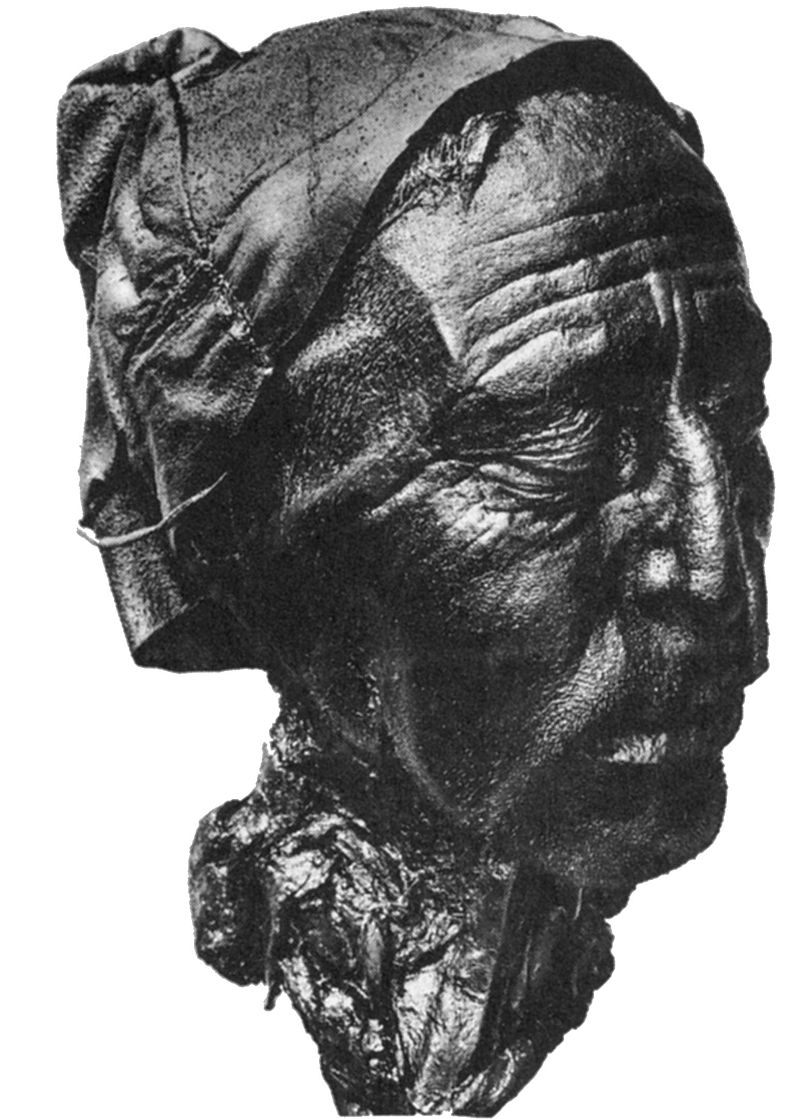
- Date of Creation: about 400-380 BCE
- Origin: Jutland Peninsula, Denmark
- Date of Discovery: 1950
- Where Displayed: Silkeborg Museum, Denmark
Undoubtedly one of the spookiest artifacts, the Tollund Man is an actual preserved body of a man who lived about 2,300 years ago in northern Europe. He was naturally mummified during the pre-Roman Iron Age and discovered in a bog on the Jutland Peninsula of Denmark.
He was so well-preserved that local authorities thought he had died recently. That was especially unnerving since he was strangled, most likely murdered, or a victim of human sacrifice.
Sophilos Vase

- Date of Creation: 580 BCE
- Origin: Attica, Greece
- Date of Discovery: Acquired in 1971
- Where Displayed: British Museum
The Sophilos Dinos, or Sophilos Vase, is one of the most beautiful of the many artifacts to survive the end of the ancient Greek civilization. Sophilos, one of human history’s earliest celebrity artists, delicately painted it.
Technically a wine bowl with a stand, it portrays the wedding of Thetis and Peleus, attended by real and mythical animals and other gods and deities.
Bust of Ramesses the Great (Younger Memnon)

- Date of Creation: Around 1270 BCE
- Origin: Thebes
- Date of Discovery: Technically never lost
- Where Displayed: British Museum
There are two of these ancient Egyptian statues. The first still stands at the entrance to the temple at the Ramesseum in Thebes, where the Egyptians buried Pharaoh Ramesses. Unfortunately, the other sculpture had to be moved to a museum since only the torso and head survive.
Napoleon first tried to pillage this colossal statue of Ramesses II in the late 18th Century. It was relocated to its current home at the British Museum in the 1820s.
Seals of Indus Valley Civilization

- Date of Creation: 2000-1500 BCE
- Origin: India
- Date of Discovery: 1870s
- Where Displayed: British Museum
The Seals of Indus Valley Civilization were unearthed in 1870 and led scholars to discover a new civilization in the Indus Valley. Archaeologists found many more treasures and objects on the site.
The fact that the civilization had a seal tells us they traded, possibly far and wide. Therefore, they would have influenced (and been influenced by) many other societies of the ancient world. There are numerous different seals discovered, they usually are square, having symbols on the top and bottom, with an animal in the center.
Flood Tablet
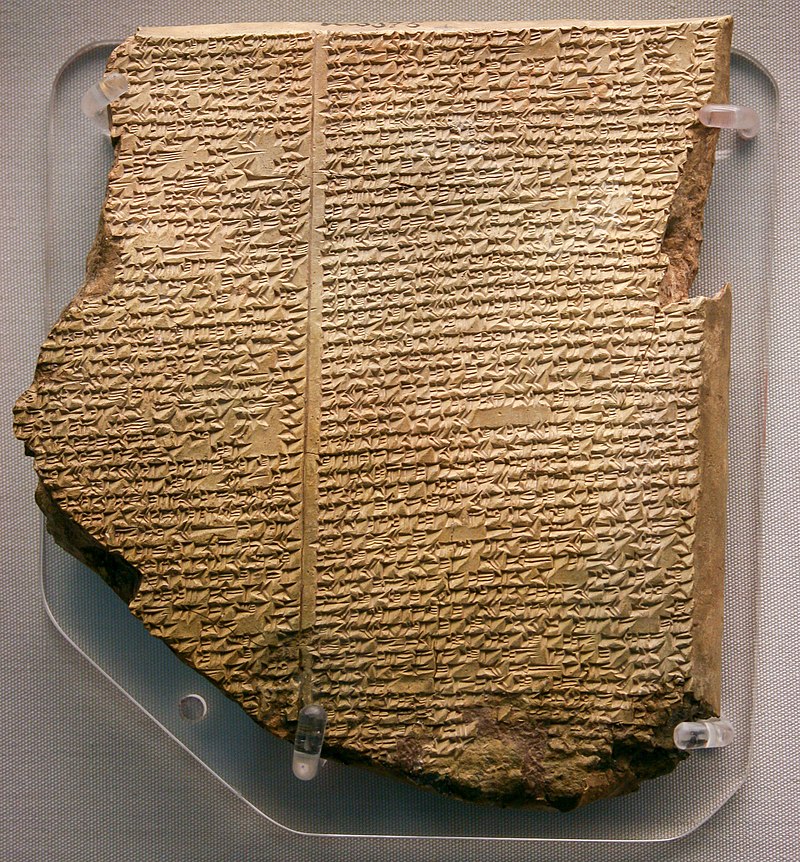
- Date of Creation: 7th Century BCE
- Origin: Nineveh, Iraq
- Date of Discovery: Mid-19th Century
- Where Displayed: British Museum
Besides Abrahamic texts, many other religious traditions and religions of the ancient world taught about a massive, destructive flood sometime in early human history. Babylonia was one of these places, and this tablet recounts the history of the infamous event.
The clay tablet is part of the Epic of Gilgamesh, and its narrative is strikingly similar to the biblical account. That indicates a high likelihood that the societies may have had a great deal of contact. It is one of eleven tablets in the Epic.
Minoan Bull Leaper
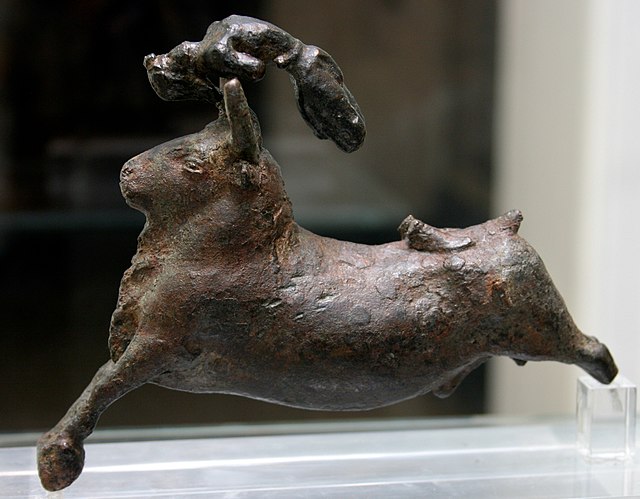
- Date of Creation: 1600-1450 BCE
- Origin: Crete
- Date of Discovery: 1921
- Where Displayed: British Museum
The Minoan Bull Leaper is a bronze statue that depicts an especially difficult—quite possibly impossible—feat of bull leaping.
Whether or not it represents an actual event, bull leaping was a prominent aspect of Minoan culture on the island of Crete.
Mold Gold Cape

- Date of Creation: 1900-1600 BCE
- Origin: Wales
- Date of Discovery: 1833
- Where Displayed: British Museum
This ceremonial cape was made from sheets of gold during the British Bronze Age. Locals found it near a burial mound outside Mold, Flintshire, Wales, where other artifacts have also been unearthed.
Because of the intricacy of the design and the materials used to make it, scholars assume that it was used in religious ceremonies or worn by influential leaders.
Oxus Chariot Model

- Date of Creation: 500-400 BCE
- Origin: Unclear, but probably present-day Tajikistan
- Date of Discovery: 1877-1880
- Where Displayed: British Museum
This artifact may be tiny, but it is remarkable. It depicts a Median chariot pulled by four small horses. Two men in traditional Median garb ride in it. It is one of many Oxus Treasures unearthed in the 19th Century in the Oxus River Valley.
The front of the chariot has a sculpture of Bes, an ancient Egyptian god usually summoned for protection. It was made of gold and silver and probably housed in a temple.
North American Otter Pipe

- Date of Creation: 200 BCE-400 CE
- Origin: Ohio
- Date of Discovery: 1846
- Where Displayed: British Museum, but similar objects are found in North America and Europe.
Precious few pre-contact artifacts remain from the indigenous peoples of the Americas. This stone pipe is likely one of them.
Found in the present-day state of Ohio in the United States, it was likely made by the cultures who built ceremonial mounds in the area. These mounds have also been preserved and can be visited.
Due to the detail in the stone carving, people probably used this pipe for religious purposes. Smokers would put the tobacco in the otter’s head. Early American peoples often smoked as part of ancient rituals.
Dancing Girl of Mohenjo-Daro

- Date of Creation: around 2500 BCE
- Origin: Present-day Pakistan
- Date of Discovery: 1926
- Where Displayed: National Museum, New Delhi, India
The Dancing Girl of Mohenjo-Daro is a vital artifact that led to several revelations about the Indus Valley Civilization. First, it revealed that they knew more about metalwork than archaeologists previously believed. She is made of bronze.
Second, the statue was found at a large and significant burial mound. Her presence at the site shows us that this civilization valued entertainment and dance as part of their culture. She is dancing and adorned with jewelry and other items that would have stood out in that culture.
Law Code of Hammurabi

- Date of Creation: 1750 BCE
- Origin: Ancient Babylonia
- Date of Discovery: 1901
- Where Displayed: The Louvre, Paris
The Code of Hammurabi remains one of the oldest known systems of codified laws in human history. It not only has historical value but literary and artistic significance as well. It is a stele with inlaid art at the top and the list of laws in the long column below it.
This artifact contains 282 complex rules handed down by King Hammurabi of Babylon. You may have heard the phrase “eye for an eye” quoted from it, but that penalty depended on your status and the rank of the person you injured.
Ishtar Gate

- Date of Creation: 6th Century BCE
- Origin: Babylon, present-day Iraq
- Date of Discovery: 1902-1914
- Where Displayed: Pergamon Museum, Berlin
The breathtaking Ishtar Gate stood at the entrance to King Nebuchadnezzar’s Babylon and was one of the original Seven Wonders of the World. Decorated with lapis lazuli and other stones, its stunning blue must have astounded visitors to the ancient city.
It was named for Ishtar, a goddess responsible for fertility, sex, love, and war. Images of the god of weather (Adad, a bull) and the patron of Babylon (Marduk, a dragon) adorn the walls.
Archaeologists meticulously unearthed and moved the parts of the gate they could recover in the 20th Century. However, it can only be seen in part due to size constraints inside the museum. Several pieces of the gate are on loan to other museums worldwide.
Battersea Shield

- Date of Creation: 350-50 BCE
- Origin: London
- Date of Discovery: 1857
- Where Displayed: British Museum
The Battersea Shield is a Celtic wooden shield covered in bronze. It has 27 opaque red glass stones surrounded by intricate bronze work, with the largest at the center. The curls and swirls of the design are in the La Tene art style.
The bronze is too thin for use in battle. Given that, the shield was probably used as a status symbol or (more likely) a votive offering.
Archaeologists found it during an excavation of the bed of the River Thames in London during bridge construction. They also discovered other Celtic and Roman artifacts from around the same time, including weapons and bones.
Are There Even Older Artifacts?
Yes, there are historical objects even older than ancient artifacts. Experts consider them prehistoric because humans had not begun to write their history (although they may have recorded it in other ways).
The scientific field of archaeology dates the prehistoric world as anything older than about 3000 BCE.
Some of the oldest artifacts in the world include:
- Lomekwi: A 21st Century discovery, this site concealed tools that experts believe could be 3.3 million years old.
- Stone tools from the Americas that are nearly 20,000 years old.
- Carved stones from the Gobekli Tepe site, a temple in present-day Turkey built about 11,000 years ago.
- Venus of Willendorf: Discovered in 1908, you can see this prehistoric feminine figure on display in Vienna’s Natural History Museum.
- Divje Babe flute: This incredible instrument was likely made by Neanderthals from the bone of a cave bear. It was found in Slovenia.
- Venus of Hohle Fels: A sculpture on display in Germany that could be 40,000 years old. It was discovered in 2008.
Frequently Asked Questions
Let’s take a look at some common questions about ancient artifacts.
What is the most famous ancient artifact?
It depends on who you ask! Indeed, the Rosetta Stone and the Dead Sea Scrolls are two of the most famous and significant. The mask of King Tut is widely recognized. All of the items listed here and thousands of others teach us about our ancestors.
What was the ancient world?
Perhaps surprisingly, the ancient world is not the oldest era in human history. Scholars broadly frame human existence into the following epochs:
- Prehistoric: From the appearance of Homo sapiens about three million years ago until about 3000 BCE.
- Ancient: 3000 BCE-about 400 CE
- Post-classical: About 400-1500 CE
- Modern: About 1500 CE-present
What qualifies as an artifact?
An artifact can be anything that shows evidence of human craft. Every day, you’re surrounded by artifacts.
Regarding what makes an artifact valuable, scholars agree that it needs to tell us something about the society that created it. If you’re wondering about market value, that’s largely dependent on what museums and private collectors are willing to pay.
How are ancient artifacts dated?
Archaeology has strong connections to science, and archaeologists found scientific methods for dating artifacts. They use various methods, including thermoluminescence, radiocarbon dating, dendrochronology, and more.
In addition, archaeologists study other similar objects to compare materials, techniques, markings, and more to help date objects.
What is the difference between prehistoric and historic artifacts?
Prehistoric artifacts are from the era before humans began writing their history down. It is sometimes called pre-recorded history.
This period began with the earliest human beings over three million years ago. It continued until about 3000 BCE. Around that time, more advanced, stratified civilizations started to emerge in different places around the world.
Conclusion
Often without even knowing it, ancient people left behind treasures of artifacts for their descendants to find. Excavations at crucial sites have informed what we know about the ancient world, helping us understand our origins and explore these remarkable human-made wonders. You can visit some of these ancient artifacts at museums and sites worldwide.
